Xiaomi Mi 8 Pro Review
Xiaomi Mi 8 Pro
Xiaomi makes a strong entrance into the UK
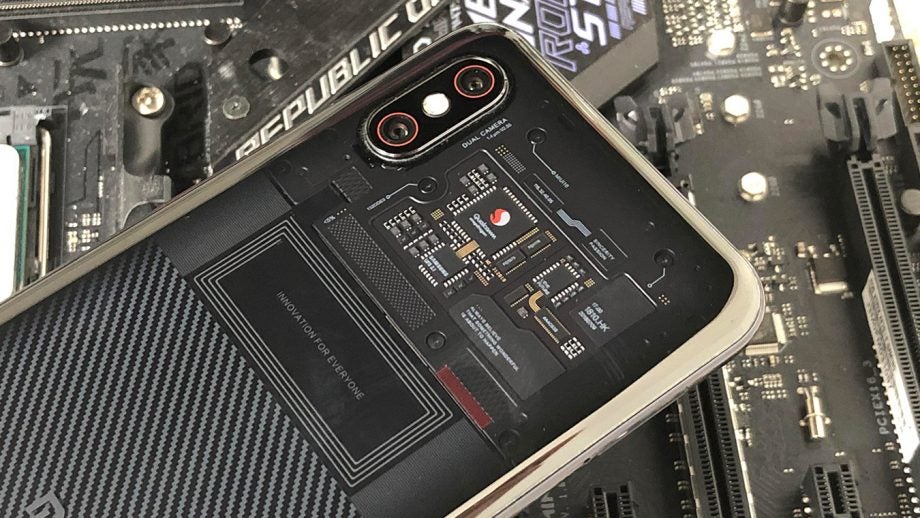
Sections
- Page 1 Xiaomi Mi 8 Pro Review
- Page 2 Camera Review
- Page 3 Battery Life and Verdict Review
Verdict
Look past the fact that the brand is still an unknown quantity in markets like the UK and the Xiaomi Mi 8 Pro packs an undeniable punch.
Pros
- Customisable software
- Eye-catching design
- Excellent camera
- Nice screen
Cons
- Poorly optimised performance
- Underwhelming battery life
- No wireless charging
- Big notch
Key Specifications
- Review Price: £499
- 6.21-inch Full HD+ AMOLED display
- Qualcomm Snapdragon 845
- 8GB RAM
- 128GB
- Dual GPS
- Dual 12-megapixel camera
- In-display fingerprint sensor
- Up to Qualcomm Quick Charge 4+ support
- IR face unlock
What is the Xiaomi Mi 8 Pro?
Chinese tech giant Xiaomi is finally ready to push into the UK market, making a statement with its launch device, the Mi 8 Pro (pronounced “me”). In fact, the company has brought a volley of hardware alongside a range of smartphones to British shores. UK tech-lovers can also expect to get their hands on the Mi Electric Scooter, Xiaomi Band 3 fitness tracker and much more.
As the name implies, the Mi 8 Pro is an enhanced version of the company’s 2018 flagship, the Mi 8, with the UK the first market outside of China where consumers could get their hands on it.
The phone sets itself apart from the crowd with a transparent-backed design, but also delivers other competitive touches such as a Snapdragon 845 processor, a dual 12-megapixel rear camera and an in-display fingerprint sensor.
Xiaomi Mi 8 Pro – Price and release date
Originally launching in China and subsequently rolling out into 25 other markets in which Xiaomi is already established, starting with the UK on November 9, the Mi 8 Pro has made a splash with the price/performance balance it strikes.
In the UK, the phone can be bought for £499. In select European markets, such as France and Spain, it’s now available for €599.
Xiaomi Mi 8 Pro – Design
The Mi 8 Pro’s body is a sandwich of Gorilla Glass 5 with a polished 7-series aluminium filling. It’s wider and squatter than the Samsung Galaxy S9 Plus, say, but covers a similar surface area, with a fit and finish that’s comparable to any top-tier handset.
The back glass curves in four directions (through processes that Xiaomi explained are particularly challenging to achieve at scale), meaning that despite its dimensions, the Mi 8 Pro is comfortable in one hand, while the materials offer plenty of grip too. However, as its Gorilla Glass, fingerprints are an issue, even after just a brief handling.

So far, so Mi 8 though. The Pro only really sets itself apart visually when you turn it over. The rear of the phone features what the company calls a “titanium smoked” transparent finish.

Xiaomi has pulled the same trick we first saw with the Mi 8 Explorer Edition, although this time the unique design has been refined somewhat. You can actually see what look like components and circuitry beneath the phone’s rear glass, with a Qualcomm-branded “chip” sitting front and centre. These aren’t the actual components, mind, they’re more there to show off the power of the phone, kind of like the way you might see ‘16v’ badged on the size of a sports car.

Can you find all the easter eggs?
Along with this, there are some little mottos, which Xiaomi describes as ‘easter eggs’ relevant to the company and the device. One of these reads ‘Always Believe That Something Wonderful Is About To Happen’. Uh huh.
It’s a rather characterful design, and surprisingly frivolous in an industry where every millimetre counts. The visible components are simply ornamental, but achieving this see-through finish is a nice touch by Xiaomi’s design team. Note that red highlights on the camera, power button and USB-C also add to the premium and interesting finish of this phone.
In the UK, at least, the Mi 8 Pro is only available in this one finish right now – but it’s easily the best option anyway.

Sadly, there are a few features that this flagship misses out on. For starters, the Mi 8 Pro is of the headphone-jack free school of thought, meaning there’s nowhere to plug your standard 3.5mm buds on the device itself. Instead, you’ll have to resort to the USB-C adapter included in the box.
There’s no wireless charging, either. This certainly isn’t a given on a flagship device, but with the Mi 8 Pro’s transparent backing showcasing the location of various real components such as the NFC reader, it would have been cool to have seen the metal coil (or at least some iconography) suggesting that the technology was present.
Most likely a cost-saving measure, Xiaomi also doesn’t reference any form of IP-certification. This means that while there’s no issue using the Mi 8 Pro in a light mist of rain, it certainly isn’t equipped to survive a dunk in the sink or a shower in the way that an iPhone XS or Samsung Galaxy S9 would.
Xiaomi Mi 8 Pro – Screen
Based on my previous experience with the Xiaomi-made Pocophone F1, I had high hopes for the Mi 8 Pro’s display – and I haven’t been disappointed. The screen is surrounded by fairly sizeable bezels and a notable chin and notch, but the AMOLED panel at play between the two is nothing short of excellent.
The 6.21-inch screen features rounded corners, a Full HD+ resolution and it’s protected by 2.5D Gorilla Glass 5.
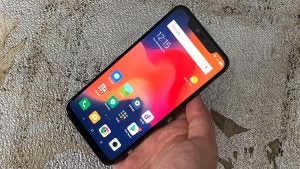
It’s bright and colourful, displaying excellent contrast, but also boasts reliable viewing angles with only a slight drop-off in brightness and practically zero colour distortion. The panel is also HDR10-compliant and offers a heap of customisability over both the viewing experience and interaction.
Related: What is HDR?
You can manually configure Night Mode brightness and colour temperature independently of the phone’s standard display settings. Plus there’s Reading Mode and manual colour and contrast controls if you want to tailor things to your taste.
The display is smart, too, with double-tap-to-wake, raise-to-wake and an always-on mode options. But the real party piece is that, unlike the standard Mi 8, the Mi 8 Pro joins a steadily expanding group of smartphones that boast in-display fingerprint sensors.

Xiaomi’s implementation is more advanced than the previous-generation technology we saw on 2017’s Huawei Mate RS, for example – factoring in depth data as well. However, while the feature is unquestionably cool on paper, and more reliable than last year’s efforts, it isn’t without its faults.
In comparison to more conventional smartphone fingerprint sensors, the Mi 8 Pro’s in-screen option is slow and, worse still, suffers from a high failure rate. I regularly found that it wouldn’t work if my hands were at all wet, damp or particularly cold. The fact that it’s invisible is somewhat amazing, but it does make it tricky to find when in a banking app, for example – or any other instance that supports fingerprint authentication (although that fact that the Mi 8 Pro’s sensor works with such experiences at all is appreciated).
The nature of the sensor also means there’s no gesture support, which is a far minor inconvenience but worth noting all the same.

Then there’s the notch. It isn’t as ugly as the one encroaching on the Pixel 3 XL’s screen, but it’s big, following in the footsteps of the iPhone X by dominating the majority of the top edge of the screen. It features the front-facing camera and an IR camera setup for face-unlock that works even in low light. Despite the technical benefits, though, it remains an eyesore.
Xiaomi Mi 8 Pro – Performance
Look beyond the faux processor visible on the Pro’s back and inside lies a legitimate Qualcomm Snapdragon 845 chip, backed up by a generous 8GB of RAM and a respectable 128GB of (non-expandable) storage.
On paper, the phone reads as well as any other high-end 2018 handset, with twice the memory of the Google Pixel 3 and the same top-tier processor as everything from the LG G7 to the Sony Xperia XZ3.
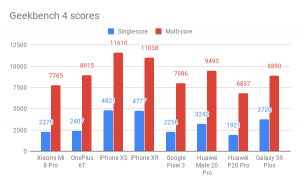
In day-to-day use this phone flies; it feels snappy in general operation, launches things quickly and is happy jumping between apps and multitasking – everything you’d expect of a flagship phone. But something isn’t quite right under the hood.
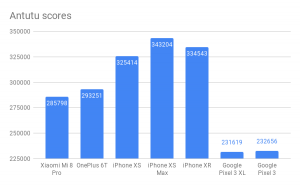
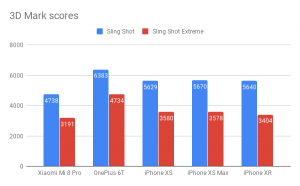
When gaming, performance takes a notable hit after just a few minutes, with frame drops that the phone can only recover from if I leave the application, or at the very least pause the game for a few moments. As the results above show, it would seem that Xiaomi just hasn’t optimised the hardware and software as well as on the likes of the OnePlus 6T, with the phone consistently scoring lower than most other top devices currently on the market.
Related: Best Mid-range Smartphones
Beyond base performance, the phone’s earpiece is well equipped to dole out clean audio during phone calls, while the single loudspeaker is again clean and loud, albeit only capable of delivering mono sound. I’ve already mentioned the innovative but sluggish fingerprint sensor – the available face unlock functionality on hand is snappier and more reliable, provided you’re comfortable with a less-secure unlock method.
There’s also the matter of dual GPS, one of the other standout features of the phone that only a few other handsets, like the Huawei Mate 20 Pro, can boast right now. It simply means more reliable and snappier GPS location services and as such, I have no complaints on its inclusion.
Xiaomi Mi 8 Pro – Software
Xiaomi’s phones sport a heavy-handed skin called MIUI that offers a wealth of customisation and control over the experience on hand, but it features some notable departures from stock Android, to the point that a little retraining might be required for some users.
The company has confirmed an OTA (over-the-air) update to MIUI 10 is inbound, which brings with it Android 9.0 Pie, adding face unlock support (which isn’t currently available when the phone’s region is set to ‘UK’), as well as more advanced selfie features too. In the meantime the Mi 8 Pro as I tested it comes running Android 8.1 with MIUI 9.6.

You have the standard on-screen navigation keys here, but there’s also the option of what MIUI calls ‘full-screen gesture’ navigation, which instead relies on swiping in from the edges of the display, not unlike iOS as it appears on every home button-free iPhone since last year’s iPhone X. It takes some getting used to but once you get your head around it, it makes for satisfying and fluid operation.
Xiaomi’s dropped in some nice touches that add an extra level of polish to the MIUI experience, like animated icons for popular services such as Instagram and Facebook, which play each time you close a supported app. The shred and explosion animation that occurs each time you delete an app is also sure to put a smile on your face.

There’s also a one-handed mode, which is appreciated on a phone with such a large display, and a swipe right from your main home screen reveals App Vault, not dissimilar to Oxygen OS’s Shelf, as found on OnePlus phones. It grants quick access to apps, widgets and features and in my opinion, helps streamline navigation.
Dive into the settings and MIUI offers an impressive level of control over the experience at hand. You can choose whether to show carrier names in the status bar, hide the notch using software, access secondary versions of apps for separate accounts, apply themes and manage background performance by way of the integrated Security app.
These aren’t features that every user will find value in but their presence at least confirms Xiaomi’s awareness of some people’s desire to sculpt and personalise their smartphone experience at a fine level, and that’s to be commended.
How we test phones
We test every mobile phone we review thoroughly. We use industry standard tests to compare features properly and we use the phone as our main device over the review period. We’ll always tell you what we find and we never, ever, accept money to review a product.


